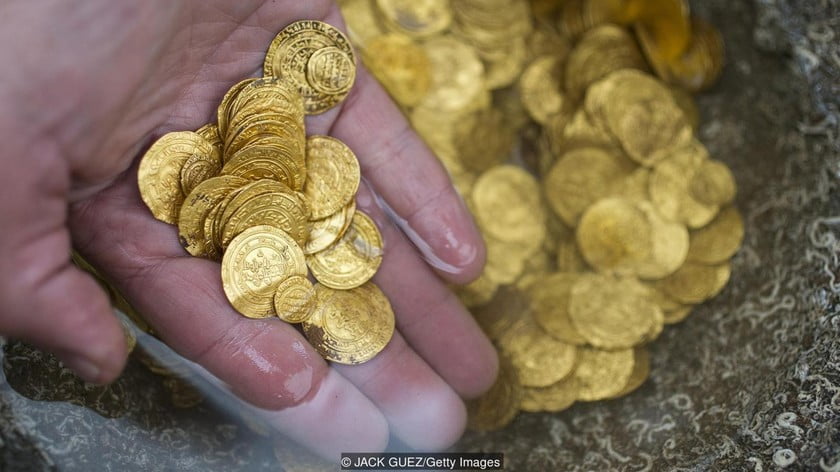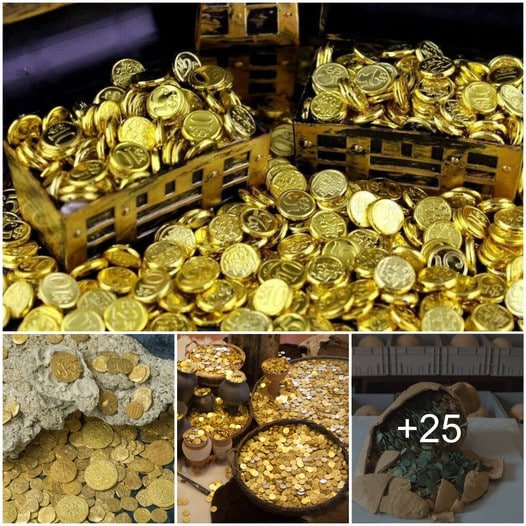This discovery ranks as one of the biggest treasures ever found along the shores of Israel.
On a cloudy morning in February 2015, Mr. Zvika Fayer, an avid scuba diver and amateur explorer, along with his friends, embarked on a dive in the sea close to the coastal town of Caesarea, Israel. To their amazement, they stumbled upon a glint of gold coins buried beneath the sandy seabed.
Prior to this remarkable discovery, a winter storm had swept through Caesarea, reshaping the underwater landscape. During their scuba diving expedition, Mr. Zvika Fayer and his companions were captivated by the shimmering sight of gold coins. Initially, they doubted the authenticity of the coins, assuming they were mere replicas. However, upon closer inspection, they confirmed that the coins were indeed genuine gold. “I was taken aback when I unearthed these gold coins,” expressed Mr. Zvika Fayer.
Israel boasts numerous underwater archaeological sites, with the government encouraging amateur divers to learn about these submerged ruins. Caesarea is a popular diving destination, favored by Mr. Zvika Fayer, who had explored its depths countless times before. Delighting in encounters with large marine life, ancient artifacts, and pottery, Mr. Zvika Fayer cherished the treasures found on the seabed.

Usually, when someone discovers a treasure, they would most likely keep it for themselves. However, Zvi Fayer was different. He immediately reported his find to the Archaeological Agency for Israel (IAA) and requested their assistance. The IAA decided to conduct further research in the area where the gold coins were discovered to learn more about this undersea treasure.
Fayer worked closely with the IAA, diving under the sea for days collecting over 2,000 gold coins. These coins are all 24 karats with a purity of up to 95%, and they have been undisturbed in the Mediterranean Sea for approximately 1,000 years. They provide valuable insights to archaeologists and historians, shedding light on a forgotten historical period.
Archaeologists in Israel consider this discovery to be incredibly valuable, both physically and historically. The gold coins are now considered national property owned by the state, and while the divers receive credit for finding the treasure, they do not receive any material rewards from the discovery.
Robert Kool, an expert on antiquity with the Israel Antiquities Authority, confirmed that the ancient coins remained intact due to the excellent preservation conditions on the seabed of Israel. It is believed that they were part of shipwrecks near Caesarea, an ancient Roman port in the Eastern Mediterranean. Despite being submerged for over a millennium, the coins are remarkably clean and well-preserved.

Ruins from ancient Rome in Caesarea are in a deteriorating condition. Once a bustling trading hub, the area is now famous for its Roman archaeological sites. The recent discovery of gold coins sheds light on Caesarea’s history during the Muslim rule. The coins were minted during the reigns of Caliphs al-Hakim and al-Zahir when Caesarea was under the Fatimid dynasty. These coins, minted in cities like Cairo and Palermo, show a unified currency system in the region. Perhaps, the coins were lost due to a shipwreck or piracy.
Since the discovery of the gold coins, researchers have been collaborating with the Israeli Antiquities Authority to explore for more treasures in and around Caesarea. They have also expanded their search to other coastal areas like Netanya, known for ancient Phoenician and Roman trading routes. For Mr. Fayer, the exploration of these underwater ancient cultures is a never-ending passion.

Ruins from ancient Rome can still be found in poor condition in Caesarea. These ancient works date back to the 4th century BC when the city was established as a bustling trading post. After being ruled by Egyptian Queen Cleopatra, the region was conquered by the Romans, and the city was later renamed Straton’s Tower by Herod the Great, a Roman-appointed king. Under his rule, Caesarea flourished with the construction of massive walls to create a seaport and amenities such as aqueducts to serve a population of over 100,000.
The city was equipped with a horse racing arena featuring smartly designed exits, a large square with seating for 3,500 spectators, temples, markets, public saunas, and a domed theater with a capacity of up to 20,000 people. In 6 AD, Caesarea became the capital of Rome in Judea and was home to prominent Roman governors like Pontius Pilate during the time of Jesus. Despite facing rebellion from the Jews between AD 66-70 and the destruction of Jerusalem, Caesarea remained the political and economic hub of the region.

